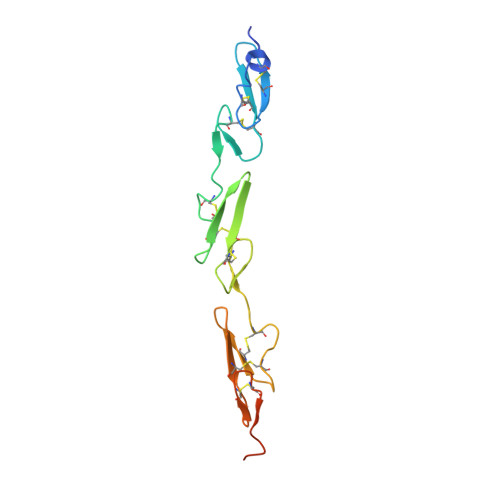Fringe-Mediated Extension of O-Linked Fucose in the Ligand-Binding Region of Notch1 Increases Binding to Mammalian Notch Ligands.
Taylor, P., Takeuchi, H., Sheppard, D., Chillakuri, C., Lea, S.M., Haltiwanger, R.S., Handford, P.A.(2014) Proc Natl Acad Sci U S A 111: 7290
- PubMed: 24803430
- DOI: https://doi.org/10.1073/pnas.1319683111
- Primary Citation of Related Structures:
4CUD, 4CUE, 4CUF, 4D0E, 4D0F - PubMed Abstract:
The Notch signaling pathway is essential for many aspects of development, cell fate determination, and tissue homeostasis. Notch signaling can be modulated by posttranslational modifications to the Notch receptor, which are known to alter both ligand binding and receptor activation. We have modified the ligand-binding region (EGF domains 11-13) of human Notch1 (hN1) with O-fucose and O-glucose glycans and shown by flow cytometry and surface plasmon resonance that the Fringe-catalyzed addition of GlcNAc to the O-fucose at T466 in EGF12 substantially increases binding to Jagged1 and Delta-like 1 (DLL1) ligands. We have subsequently determined the crystal structures of EGF domains 11-13 of hN1 modified with either the O-fucose monosaccharide or the GlcNAc-fucose disaccharide at T466 of EGF12 and observed no change in backbone structure for each variant. Collectively, these data demonstrate a role for GlcNAc in modulating the ligand-binding site in hN1 EGF12, resulting in an increased affinity of this region for ligands Jagged1 and DLL1. We propose that this finding explains the Fringe-catalyzed enhancement of Notch-Delta signaling observed in flies and humans, but suggest that the inhibitory effect of Fringe on Jagged/Serrate mediated signaling involves other regions of Notch.
- Department of Biochemistry, University of Oxford, Oxford OX1 3QU, United Kingdom;
Organizational Affiliation:


















